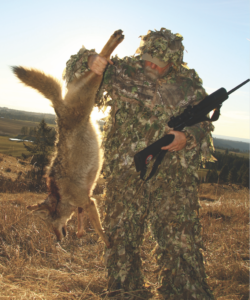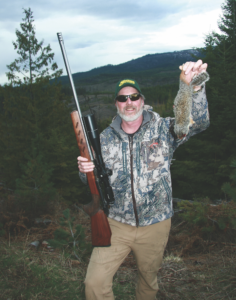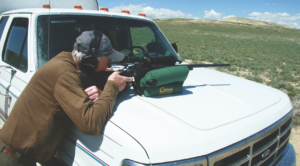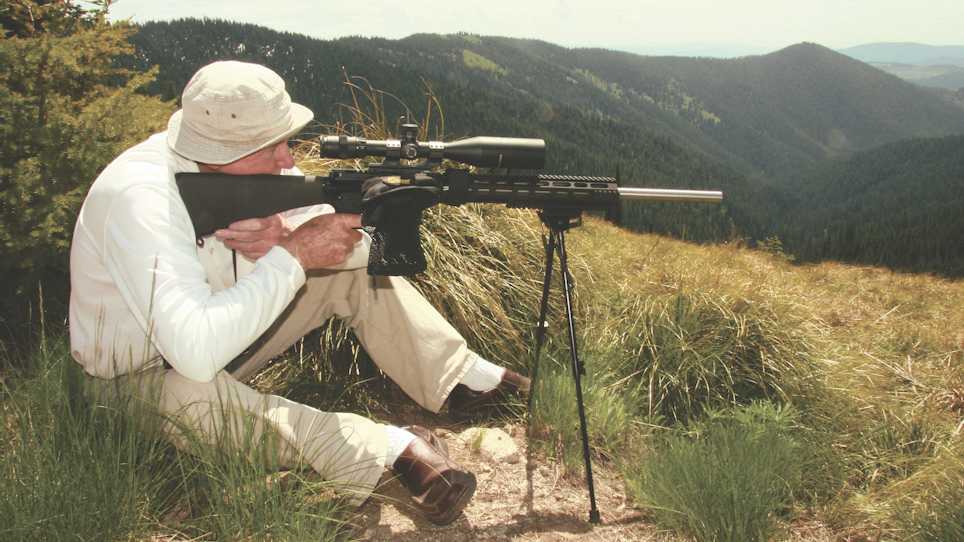The .250 Savage took the shooting world by storm when it became the first commercial cartridge to break 3,000 feet per second. It wasn’t called the .250 Savage back then, but instead was called the .250-3000 with clever marketing wrapped around an unusual cartridge label.
Savage accomplished this by loading an 87-grain bullet, which was not the 100-grain bullet originator Charles Newton had in mind while contemplating use on deer-sized game. Now, 3,000 fps may not seem impressive by today’s standards, but in 1915, when the cartridge appeared, it was newsworthy.
In the new millennium, rifle shooters are still speed obsessed. But varmint/predator shooters take this need for speed into new realms while maintaining impressive accuracy.
In the universe of small-varmint shooting — diminutive ground squirrels, prairie dogs and ‘chucks in particular —“fast” invites different definitions. When varmints are small and ranges long, the magic number becomes 4,000 fps. Only a handful of rounds win a place on the 4,000-fps podium, and of these some can be immediately eliminated due to the scarcity of rifles and/or ammo.
For example, the tack-driving .22 PPC can produce 4,000 fps, if you force the issue with 40-grain bullets seated over maximum loads of H322, but the cartridge isn’t exactly mainstream. The .224 Weatherby Magnum is capable of 4,000 to 4,100 fps velocities, the .22-250 Ackley Improved 4,300 to 4,000 fps with 40 to 45-grain pills, respectively, but when was the last time you encountered a rifle chambered for these rounds? So for our purposes we’ll stick to well-established cartridges, and common loads well under maximum pressures.
.17 Remington Fireball
Released in 2008, the .17 Remington Fireball (FB) was celebrated by varmint-shooting ranks. Similar to Vern O’Brien’s .17 Mach IV of the late 1960s, the .17 Fireball was created by necking down the .221 Remington Fireball.

Coyotes and varmints don't stand much of a chance with bullets cracking the 4,000-fps barrier. (Photo: Patrick Meitin)
Developed for the Remington XP-100 pistol in 1963, the .221 is remarkably efficient. The .17 (FB) inherits that quality, producing 4,000 to 4,050 fps velocities with 20-grain bullets with as little as 16 to 20 grains of powder. That means more shooting per pound of powder, and less cleaning between shot strings.
The .17 FB offers pleasant shooting, producing recoil so light it’s easy to mark your own shots, even through powerful optics. While handloaders must weigh powder charges carefully due to the small amounts involved, the .17 FB isn’t particularly fussy, producing sub-½-inch accuracy from quality firearms after only minimal load development.
With a sub-maximum 19.5 grains of Western Powder’s Ramshot X-Terminator beneath a 20-grain Hornady V-Max, the .17 FB easily breaks 4,000 fps while producing impressive splat factors on small varmints. This load clusters 5-shot groups into a single ragged hole from my Remington Model 700 SPS Varmint. Push loads to max and you’ll receive only 50 fps for your troubles. Add only 5 grains to bullet weight and top velocities drop to 3,750 fps.
.17 Remington
The .17 Remington, introduced in 1971, was the first .17-caliber cartridge offered in both factory rifles and commercial ammunition. The .17 Rem. also reigns as one of the fastest commercial cartridges around, breaking 4,300 fps with 20-grain bullets and 4,100 fps with 25-grain pills. Such speeds make ricochets unlikely, marking the .17 Remington as ideal in populated areas. The .17 Remington offers mild recoil and laser-like trajectory to make range judging to 350 yards unnecessary — though low ballistic coefficients limit maximum effective range to yardages not much farther than this.

The .22-250 is a smoking hot round that will reach out and touch a varmint, like this one that toppled at 398 yards. (Photo: Patrick Meitin)
Early on the .17 Remington developed a reputation for burning barrels. When I purchased my .17 Remington in the early ‘80s, .17-caliber cleaning rods weren’t widely available, which might explain much of the problem. The .17 Remington requires frequent cleaning. If I still owned a .17 Remington (I let mine go in one of those trades later regretted) I’d deploy a bore snake after every 25 rounds.
I traded that Ruger M77 because I’d purchased it seeking a coyote killer that wouldn’t damage hides during a period of record-high fur prices, and .17 bullets of the day proved terminally unreliable at top velocities, often splattering on contact. That situation has improved substantially. Barrel wear is mitigated by new powders and barrel steels, though allowing barrels to cool between fusillades assures your .17 Remington barrel remains tiptop.
Shooting 25- instead of 20-grain bullets gives the Remington an edge over the Fireball. While 20-grain pills can be pushed to 4,300 fps with max loads (4,200 with a wide variety of powders loaded below maximum), 4,000 to 4,100 fps is easy enough with 25-grain bullets, providing a bit more reach, and improved reliability on large predators such as mountain or northern coyotes.
Back in the day Winchester 760 was the go-to fuel and remains so today. A load of 27.5 grains of W760 beneath Nosler’s 25-grain Ballistic Tip easily breaks 4,000 fps without undue pressures, and does a job on small varmints and predators — turning the former into red mist, rarely exiting on the later.
.204 Ruger
Created by necking down the defunct .222 Remington Magnum, the .204 Ruger has emerged as a varmint-shooting firebrand. It does its best work with 32-grain bullets, breezing across the 4,000 fps threshold without breaking a sweat, even shooting 4,100 to 4,200 fps with select powders. Terminal results are spectacular, often sending ground-squirrel parts spinning dramatically following solid hits. The .204 remains pleasant to shoot, offering soft recoil in conjunction with super-flat trajectories that carry farther than the .17s.
After acquiring my first .204 Ruger — an affordable Savage Model 25 Walking Varmint — I conducted quite a bit of load development. What I discovered is the .204 isn’t all that fussy about bullets or powders. Five different propellants effortlessly assembled sub-½-inch groups. That rifle went away in a trade, immediately replaced by a Mossberg MVP Varmint. Since there was no major difference in group size with my initial test loads I opted for pure speed, incidentally falling on a load providing surgical precision, translated to mean effortless one-hole groups.
Results may differ in your rifle, but 28.5 grains of Vihta Vouri N-140 sends a 32-grain Nosler Tipped Varmageddon (a more affordable alternative to the Ballistic Tip) off the blocks at around 4,100 fps, turns ground squirrels and prairie dogs to mush and shoots one-hole groups from the aforementioned Mossberg. You can gain 100 fps with 32-grain pills, but only by trickling maximum loads of VV N-140.

The .17 Fireball is a popular round for varmint hunters thanks to its blazing speed and flat trajectories. (Photo: Patrick Meitin)
.22-250 Remington
Despite its reputation as an across-the-board barn burner, the ‘250 breaks the 4,000 fps threshold only with light 40- to 45-grain bullets — not exactly a Greek tragedy, as it spits out 4,175 to 4,000 fps, respectively, and with excellent accuracy. The .22-250 has been offering such velocities since 1967 — at least as a commercial cartridge, the round appearing some 30 years prior as a wildcat round. Personal experience hints that the .22-250 is a touch finicky. For instance, I can load five or six different .223 Remington loads, including different weight bullets, and typically maintain minute-of-squirrel groups. With my .22-250 Remington, changing even bullet brands within the same weight often results in disparate points of impact.
My own .22-250 Remington — a customized ’98 Mauser holding a heavy-contour stainless barrel, Timney trigger and chunky target-style stock — provided some frustrations during load development, yet once the right combination fell together it delivers five-shot groups easily covered by a dime, and 200-yards groups of less than 1½ inches. The 1:14 rifling twist traditionally given makes the .22-250 makes 40-grain pills a natural choice.
There is a long list of powders providing 4,000 fps velocities with 40-grain bullets, and without pushing pressures toward maximum. Some of the most readily available include H335 (35.5 grains), IMR4064 (35.5 grains), Reloader 15 (37.5 grains), Varget (37.4 grains), Vihta Vouri N-140 (37.5 grains) and Winchester 748 (38 grains). Achieving 4,100 fps is possible with these powders, if you’re willing to flirt with maximum pressures.
Newer Hodgdon CFE-223 provides velocities of up to 4,200-4,300 fps, the later with a maximum load of 43 grains. I backed off to 41 grains, still breaking 4,100 fps and assembling one-hole, five-shot groups at 100 yards and the abovementioned sub-1½-inch groups at 200. Last spring, after considerable ballistic-charts consultation, I made a cold-shot kill on a Columbia ground squirrel across 398 yards of breezy mountain canyon with this load.
.220 Swift
After 82 years on the varmint-shooting scene the venerable .220 Swift is still one of the fastest commercially-available cartridges available. The Swift has been dazzling with 4,200 fps velocities since 1935, when it was introduced by Winchester in their Model 54 bolt action rifle.
The Swift is based on the semi-rimmed 6mm Lee Navy case necked to .224 caliber, with a bit of body taper removed and the shoulder sharpened. Early in its career the Swift developed a reputation for ruining barrels, but newer powders and cleaning technologies, and especially improvements to barrel steel, have largely put those fears to rest. Like the .17 Remington, allowing the .220 Swift to cool between shot strings — and backing away from maximum loads — improves barrel life considerably.
The sporter-barreled Ruger M77 Swift I owned in the mid to late 1980s accounted for literally hundreds of coyotes (at a $50 average from local fur buyers) and proved both undemanding at the loading bench and impressively accurate in the field. I chose 40-grain bullets for the edge provided on running coyotes at extreme ranges. In those days of record-high fur prices you shot at coyotes until they were clean out of sight, meaning I made some of the luckiest shots of my life with the Swift, killing running coyotes out to 500 to 700 yards.
It’s possible to push 40-grain bullets to 4,300 fps from the Swift, but I avoid maximum loads in difference to barrel life and overall accuracy. Hitting or surpassing 4,200 fps with 40-grain pills is easy enough, without dealing with maximum pressures, using 37.5 grains of IMR3031, 39 grains of H4895 or 40 grains of Reloader 15 — 4,300 fps possible with the same powders and maximum charges. In 45-grain pills, VV N-140 (40.5 grains) and H414 (43.5 grains) will get you to 4,100 fps at below max, or 4,200 fps with maximum loads. You can just touch 4,000 with 50-grain pills, but only by pushing the pressure envelope with IMR4064 and H414 powders.
As an obsessive small-varmint shooter and predator hunter I can tell you speed is addicting. It minimizes turret or hold-over corrections between shots taken at various ranges, helps cheat a desert or prairie breeze (within reason), provides spectacular, rodent-dismantling impacts on small varmints and dead-right-there kills on larger predators — to say nothing of greatly reducing lead gaps on fleeing coyotes to make hits surer.
If you’re serious about varmint shooting or predator hunting, these are the rounds and loads you’ll eventually turn to, as this isn’t a tickling contest, and speed kills.






